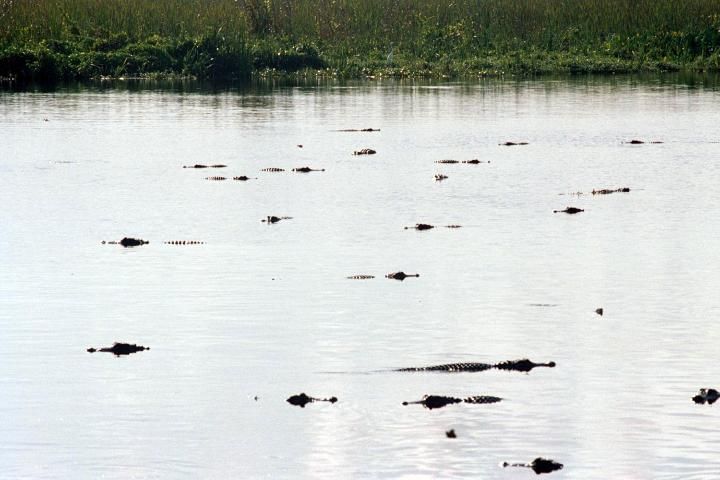The American Alligator: An Indicator Species for Everglades Restoration
The American alligator once occupied all wetland habitats in south Florida, from freshwater marshes and swamps to mangrove estuaries. As development and water-management practices have reduced the quantity and quality of these habitats, alligator populations have declined throughout the Greater Everglades.
Everglades restoration aims to enhance quality of natural areas and improve abundance and diversity of native species, while also meeting urban and agricultural water demands. Because it is impossible to monitor everything in an ecosystem, a suite of "ecological indicators" is needed to assess restoration effectiveness. Indicators must be representative of the ecosystem, responsive to changes, easily monitored, and understandable to managers and policy makers.
The alligator is an indicator of ecosystem responses to Everglades restoration because it is sensitive to hydrology, salinity, and system productivity, all factors that are expected to change as a result of restoration.


Credit: Wellington Guzman, University of Florida
Alligators are highly responsive to changes in their environment. As Everglades restoration affects water- management practices and hydrologic conditions (depth, duration, timing, spatial extent, salinity, and water quality), monitoring trends in alligator populations can help to assess positive or negative responses of the ecosystem.
The measures used to monitor alligator populations include relative abundance (animals per km), body condition (relative fatness), and occupancy rates of alligator holes. These measures are easy to understand and provide answers to the following questions: How has the number of alligators changed? Are alligators fatter or thinner than they should be? Are they in the places where they should be?
No other species defines the Everglades as does the American alligator. It is an excellent indicator species because it is valued and understood by managers, decision-makers, and the public. Having the alligator on the list of system-wide, general indicators provides us with one of the most powerful tools we have to communicate progress of ecosystem restoration in Greater Everglades ecosystems to diverse audiences.

Credit: Jemeema Carrigan, University of Florida
Alligators and Hydrology
Water depths and durations in the Everglades have been transformed by drainage and impoundment. Thus in many areas where alligators once existed, they have disappeared or are only present in permanent water bodies (canals, ponds) or during periods of extremely high water. Water depth and duration also affect health of alligators by impacting their food supply. Monitoring alligator abundance and health (body condition) across various Everglades habitats can indicate suitability of hydrologic conditions for both alligators and their prey species.
Alligators and Salinity
Salinity is a limiting factor for the distribution and abundance of alligators in coastal areas of the Everglades. Freshwater flow into estuaries directly affects locations of alligators, most of which are found in areas of lowest salinity. Restoring a productive freshwater (oligohaline) zone to Everglades estuaries, with alligators of all size classes present, would be a sign of successful restoration.
Alligators and System Productivity
Alligators are top predators and "ecological engineers" that affect nearly all aquatic life in the Everglades. The holes and trails that alligators build provide refuge for fish and food for wading birds during the dry season, and their nests provide elevated areas for nests of other reptiles and germination of plants less tolerant of flooding. Therefore, an increase in alligator holes and nests, and alligators maintaining them, will be an indicator of Everglades restoration success.

Credit: Brian Jeffery, University of Florida
Alligators in Canals
Alligators are found in canals throughout the Greater Everglades, but these populations are dominated by adults, particularly adult males. Canals do not provide suitable habitat to sustain a healthy alligator population:
-
Canals lack shelter for small alligators, making them vulnerable to predation and cannibalism. Alligator hatchlings are unlikely to survive in canals.
-
Manipulations of canal water levels result in frequent flooding of alligator nests.
-
Alligators that rely on canals may no longer build and maintain alligator holes.
The Comprehensive Everglades Restoration Plan's "decompartmentalization" project (Decomp) aims to restore sheet flow by removing barriers such as canals, levees, and roads. One of Decomp's short-term objectives is to eliminate harmful effects of deep-water canals on fish populations. A long-term objective is to increase the proportion of juvenile alligators in natural wetland habitats. Therefore, monitoring abundance of alligators in natural wetland habitats of the Everglades will help to assess whether restoration projects such as Decomp are achieving their objectives.
For more information contact:
Frank J. Mazzotti
UF/IFAS Fort Lauderdale Research & Education Center
3205 College Ave., Davie, FL 33314
Email: fjma@ufl.edu


